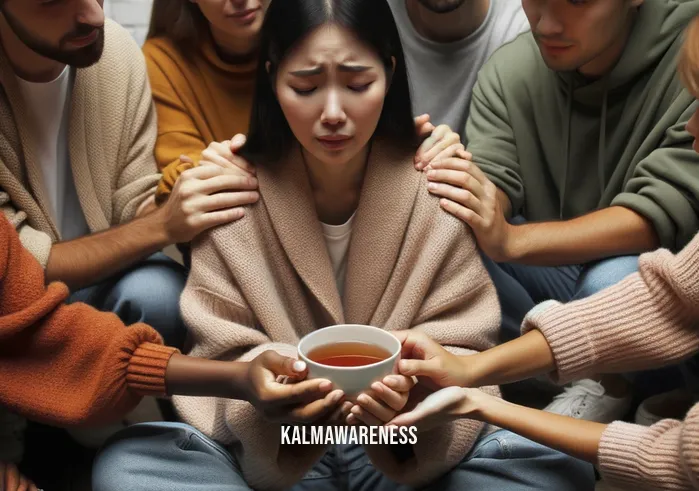Exploring the Depths of “Are You Blue”: A Journey into Emotional Wellness
Have you ever caught yourself feeling inexplicably down, as if a cloud of sadness just won’t lift? This sensation, often described as feeling “blue,” is more than just a fleeting mood. It’s a complex emotional state that can weave through our lives, impacting our mental health, relationships, and overall wellbeing. Let’s dive into what it truly means to be “blue” and how it differs from other emotional states.
The Essence of Feeling Blue: More Than Just Sadness
At first glance, feeling blue might seem synonymous with sadness, but it’s a more nuanced emotion. It encompasses a range of feelings, from mild melancholy to a deep, lingering sense of sorrow. Unlike acute sadness triggered by a specific event, being blue often doesn’t have an identifiable cause. It’s like a gentle wave of gloom that washes over you, sometimes without warning.
In our fast-paced, constantly-connected world, acknowledging and understanding these emotions is vital. We often brush aside these feelings, attributing them to stress or a busy lifestyle. However, recognizing the subtleties of feeling blue is the first step towards emotional wellness. To dive deeper into this, consider exploring resources like Understanding Emotional Health for more insights.
The Impact on Daily Life
The impact of feeling blue can be subtle yet pervasive. It might manifest as a lack of motivation, a decrease in enjoying activities that usually bring joy, or a general sense of lethargy. It’s important to note that these feelings are normal; everyone experiences them at some point. However, when they start to interfere with daily life, it’s essential to take a closer look.
One effective way to address these feelings is through mindfulness and meditation. Practices like Meditation for Emotional Balance can provide tools to manage and understand these emotions better. By creating space to explore your inner world, you can start to unravel the reasons behind feeling blue and find ways to bring more joy and contentment into your life.
The Role of Self-Compassion and Community
It’s crucial to approach these feelings with self-compassion. Being hard on yourself for feeling down only exacerbates the situation. Instead, embracing self-compassion can be a powerful tool in navigating through these emotions. Engaging with resources like Self-Compassion Journal Prompts can provide a starting point for this journey.
Additionally, the role of community shouldn’t be underestimated. Sharing your feelings with trusted friends or family members can provide a different perspective and much-needed support. Sometimes, just knowing that others have shared similar experiences can be incredibly comforting and help alleviate the sense of isolation that often accompanies feeling blue.
In this first part of our exploration into “Are You Blue,” we’ve delved into the essence of this emotional state, its impact on daily life, and the importance of self-compassion and community support. But what happens when these feelings linger or become overwhelming? Could they be a sign of something deeper, like depression? Stay tuned as we explore this intriguing question in the next section and uncover more about the fine line between feeling blue and more serious emotional conditions.

Navigating Through Shades of Blue: Understanding Deeper Emotional States
In our journey to understand the nuances of feeling “blue,” it’s essential to recognize when these emotions might indicate something more profound. Sometimes, what starts as a fleeting sense of melancholy can evolve into a persistent emotional state that impacts our mental health more significantly than we initially realize. This section delves deeper into distinguishing between temporary blues and more serious conditions like depression.
The Thin Line Between Blue and Depression
It’s crucial to understand the fine line that separates a general feeling of being blue from clinical depression. While both can share similar characteristics, such as low mood and lack of motivation, the intensity and duration differ significantly. Depression is a clinical condition characterized by persistent and intense feelings of sadness, hopelessness, and worthlessness, often accompanied by physical symptoms like changes in appetite and sleep patterns.
Key Distinctions:
- Duration: Feeling blue is often transient, while depression lasts for a prolonged period, typically more than two weeks.
- Intensity: The intensity of emotions in depression is usually higher, significantly impacting daily functioning.
- Physical Symptoms: Depression often has physical manifestations, such as changes in sleep and appetite, which are less common in milder emotional states.
To gain more insight into the intricacies of these emotional states, resources like Understanding Emotional Wellness can be invaluable.
When to Seek Help
Recognizing when it’s time to seek professional help is a crucial aspect of mental health care. If feelings of being blue persist and start affecting daily activities, it might be time to consult a mental health professional. It’s essential to remember that seeking help is a sign of strength, not weakness. Early intervention can significantly improve the quality of life and provide the necessary tools to manage these emotions effectively.
Table: Indicators for Professional Help
| Emotional State | Duration | Impact on Daily Life | Physical Symptoms |
|---|---|---|---|
| Feeling Blue | Short-term | Minimal | Rarely Present |
| Depression | Long-term | Significant | Often Present |
For those exploring meditation and mindfulness as a tool for emotional balance, consider resources like Binaural Beats for Depression for an alternative approach.
Empowering Yourself Through Knowledge and Action
Knowledge is power, especially when it comes to managing our emotional health. Understanding the different aspects of feeling blue and its potential progression into depression is crucial. This understanding empowers us to take proactive steps in caring for our mental well-being. It’s about recognizing the signs, knowing when to seek help, and utilizing available resources to maintain a healthy emotional state.
As we conclude this section, we find ourselves contemplating an important question: How can we proactively manage these emotions to prevent them from escalating into something more severe? Can lifestyle changes, mindfulness practices, or professional interventions make a significant difference in our emotional well-being? These questions set the stage for our final section, where we’ll explore practical strategies for managing and transforming our emotional landscape, leading towards a more balanced and fulfilling life.

Embracing the Blues: Transforming Emotional Challenges into Growth Opportunities
As we reach the culmination of our exploration into the emotional landscape of being “blue,” it’s time to weave together our understanding and consider practical steps for transforming these feelings into opportunities for personal growth and emotional resilience.
Harnessing Emotional Awareness for Personal Growth
The journey through understanding and managing feelings of being blue is fundamentally about self-awareness. Recognizing these emotions as they arise and understanding their impact on our lives is the first step toward mastery over them. This awareness becomes a powerful tool, enabling us to make informed decisions about our mental health and overall well-being.
Actionable Steps:
- Mindfulness Practices: Regular mindfulness exercises, such as meditation or yoga, can increase self-awareness and emotional regulation. Consider trying Guided Meditation for Emotional Balance to start your practice.
- Journaling: Writing down your thoughts and feelings can provide clarity and perspective. This is where resources like Self-Compassion Journal Prompts can be especially useful.
The Power of Support Systems and Professional Guidance
Building a strong support system and seeking professional guidance when necessary is crucial. Engaging with friends, family, or support groups provides a sense of belonging and shared understanding. Furthermore, mental health professionals can offer tailored strategies and therapies to manage emotional states effectively.
Looking Ahead: Future Applications and Ongoing Learning
As our understanding of emotional health evolves, the concept of being “blue” can be applied in various scenarios. From workplace wellness programs to educational curriculums, integrating emotional wellness practices can lead to healthier, more empathetic communities. Moreover, continual learning through resources such as books, articles, or courses is vital for staying informed and proactive about our emotional health.
Engaging Call-to-Action:
- Explore further into the world of emotional wellness by engaging with resources like Breathing Techniques for Anxiety Relief.
- Stay informed and inspired by subscribing to newsletters or blogs focusing on mental health and emotional well-being.
Key Takeaways
- Understanding the Spectrum: Recognize the difference between temporary blues and more serious conditions like depression.
- Proactive Management: Employ mindfulness practices and journaling for greater emotional awareness and regulation.
- Seeking Support: Build a supportive community and consider professional guidance for deeper emotional challenges.
- Future Applications: Apply these insights into various aspects of life, from personal development to community initiatives.
In our journey through the intricate shades of being “blue,” we’ve explored the depths of our emotional states, recognized the importance of awareness, and discussed actionable strategies for growth. As we conclude, remember that feeling blue, while challenging, also offers a unique opportunity for emotional development and resilience. May this exploration inspire you to embrace your emotions as gateways to deeper understanding and personal transformation.





